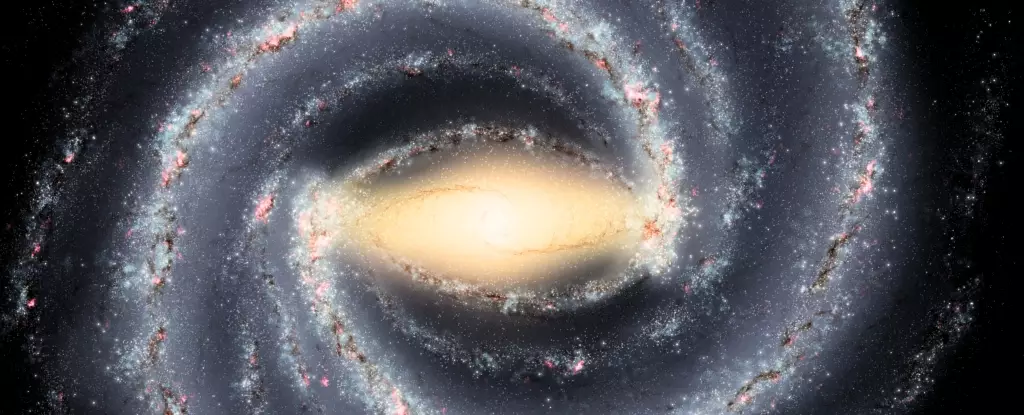For centuries, humanity’s comprehension of Earth’s geological history has largely revolved around terrestrial phenomena—volcanoes, tectonic shifts, and asteroid impacts. These natural processes have been meticulously studied, revealing invaluable insights into our planet’s formation and evolution. However, emerging scientific narratives challenge us to think bigger, suggesting that Earth’s deep-time geology might be intricately linked to the grand dance of stars within our galaxy. This revolutionary perspective shifts the emphasis from purely internal geodynamics to the celestial theater of the Milky Way, positing that our planetary destiny could be influenced by cosmic cycles spanning hundreds of millions of years.
This is not a marginal theory but a bold hypothesis that urges us to reconsider Earth’s history in a broader galactic context. If the rhythms of the cosmos influence crust formation, volcanic activity, and even biological evolution, then perhaps our understanding of Earth’s past is incomplete without acknowledging these extragalactic factors. Such a paradigm invites a more holistic view—one that entwines the geological narrative with the dynamic movements of the galaxy, hinting at a universe where planetary developments are not isolated phenomena but responses to cosmic pulsations.
Connecting the Dots: From Atomic Hydrogen to Zircon Clues
The foundation of this galactic geology theory hinges on sophisticated observational techniques and mineral analysis. Astronomers utilize the 21-centimeter emission of atomic hydrogen—the universe’s most abundant element—as a cosmic marker delineating the structure of our galaxy. This emission penetrates cosmic dust, revealing the elusive spiral arms that wind through the Milky Way. These arms are not rigid structures but regions of heightened density, akin to traffic jams of stars and gas winding around the galactic core.
As our Solar System orbits the galactic center, it periodically traverses these dense spiral arms approximately every 180 to 200 million years. This periodic crossing correlates with potential upheavals in the space environment surrounding Earth. But how can such distant galactic processes leave tangible imprints on geological records? The answer lies within tiny mineral grains—zircons—that serve as resilient timeline capsules. These minerals preserve chemical signals from Earth’s primordial conditions and record fluctuations in isotopic compositions over billions of years.
By analyzing zircon oxygen isotopes, scientists can infer ancient environmental and magmatic processes, revealing deviations that suggest external disturbances. When these isotope anomalies align temporally with Earth’s passage through the galaxy’s spiral arms—regions enriched with hydrogen gas—the implication is profound: galactic positioning might influence crustal behavior. Such correlations imply that the cosmic environment impacts the frequency or intensity of geological events, perhaps even modulating the influx of cometary impacts as the Solar System agitates the distant Oort Cloud.
Implications and the Challenges of Cosmic-Ground Connections
The prospect that galactic cycles influence Earth’s crust is as fascinating as it is contentious. For one, it challenges the traditionally Earth-centric view of planetary evolution, introducing a celestial dimension that complicates the causes behind crustal stress, impact history, and potentially, the emergence of life itself. If impacts driven by passing through spiral arms spark geological upheavals, then Earth’s habitability might be intertwined with galactic rhythms, suggesting a universe where life’s development is periodically fostered or hindered by cosmic timing.
However, this hypothesis must be approached with caution. Correlation, after all, does not establish causation. Earth’s geological records are notoriously complex, subject to multiple influences—tectonic plates, volcanic activity, oceanic processes—that can mimic or obscure galactic signals. Furthermore, the certainty with which scientists can correlate zircon isotope fluctuations to galactic crossings relies heavily on models with gaps and assumptions. Yet, dismissing these findings outright would be short-sighted; they underscore the importance of considering external cosmic factors in geological and biological evolution.
In this context, zircon grains emerge as crucial witnesses—tiny but powerful indicators—holding secrets of an unseen galactic influence. If confirmed, this connection could redefine our approach to planetary science, recognizing that Earth’s future and past are, in part, governed by the vast, rhythmic waves of stellar activity echoing across the galaxy. It emphasizes a need for interdisciplinary research—melding astronomy, geology, and planetary science—as we strive to understand our place in the universe’s expansive dance. Moving forward, embracing these cosmic links could be vital in unraveling mysteries about Earth’s habitability, resilience, and the broader narrative of life in the universe.

